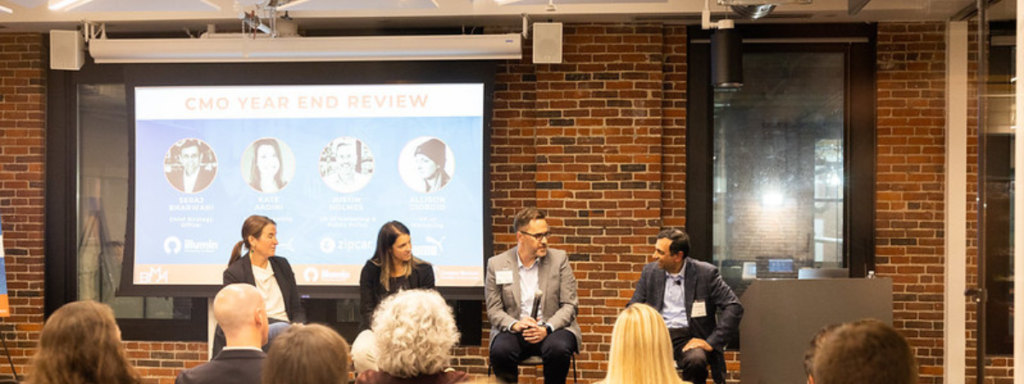On November 3, we hosted our last BIMA thought leadership event of the year, “CMO: Year End Review,” featuring a panel of top marketing talent from some of the most recognizable brands in consumer fashion, insurance, and transit.
The panel was moderated by lifelong marketer, Seraj Bharwani, Chief Strategy Officer, illumin (powered by AcuityAds) and featured (pictured left to right in the photo below): Kate Ardini, Chief Marketing Officer, John Hancock, Allison Giorgio, VP, Marketing, Puma North America, Justin Holmes, VP, Marketing and Public Policy, Zipcar. The event gathered marketers at a time when our real lives and work lives have never been more intertwined, brands navigate how to take part in conversations around political and societal issues, and as the pandemic feels like it is behind us a recession is looming—a complicated time indeed.

While many CMO roles can be a rotating door (according to SpencerStaurt, the average tenure is just 43 months), the average tenure in this panel is a decade in their current roles.
These brands collectively expressed that they feel they have weathered the storm of COVID and the business continuity challenges that came with it. They look ahead to 2023 feeling like “it is game time, the world has changed, but we made it” as Allison Giogio said and, “for some businesses, the pandemic created a resurgence and captured new demand. If we weathered the last 2.5 years, we can weather a recession, we can do anything,” as Justin Holmes shared. It was a panel full of energy and optimism for what lies ahead.
So, what did these long-term leaders say about what worked and what didn’t in 2022, and what’s to come in the year ahead? Here are the key takeaways.
Consumer expectations and attitudes have changed: focus on the customer journey and be nimble
As Kate Ardini from John Hancock shared, “expectations have changed, people think about health and wealth differently now.” COVID has changed expectations, priorities, and the vantage point consumers bring to every transaction they make. To her, marketing had felt siloed with a focus on departmental roles in marketing, IT, and the customer journey. In 2022, John Hancock shifted to making choices focused on the customer journey, versus department roles, which helped them to be more agile and connected to the external market
Allison Giogio from Puma echoed the importance of brands being nimble and adaptable. Puma is part of one of the fastest-growing and hungriest industries, but product delays and changing consumer sentiment on everything from political to societal issues caused them to look at “everything they believed they needed to be.”
For intangible products that don’t stay top of mind for consumers naturally, gamification can build brand connections and engagement
Life insurance: it’s not something consumers ever directly benefit from buying. They are buying peace of mind. As a result, folks generally interact with their life insurance provider twice a year, for billing and review of an annual prospectus. How do brands with products like this engage them between billing cycles? For John Hancock, getting their customers to focus on living and not just think about dying when they think about life insurance was the answer. A partnership with Vitality gamified healthy living for John Hancock’s customers. They logged sleep, healthy eating, number of steps, doctors visit, vaccinations, and more to earn gift cards and savings on premiums. This led to 25 interactions a month with the brand (versus maybe 1-2/year), an 80% improvement in the health of customers enrolled in the program, and something for the producers selling the policies to talk about as a differentiator for John Hancock’s services. A win for all parties involved.
Be authentic and align with a societal purpose
Zipcar was part of the sharing economy before that term existed. The company was founded by two female entrepreneurs seven years before the iPhone debuted. They support low-car and multi-modal lifestyles. This category of innovative mobility supports sustainability: every Zipcar vehicle takes away 13 privately owned vehicles and a ton of carbon emissions. This is a clear purpose for Zipcar. For brands like John Hancock, the new initiative with Vitality helps them define a purpose—helping their clients live better quality lives.

Brands need to be sharp about what they stand for and ensure that they articulate an authentic point of view throughout their brand evolution. For some brands (like Zipcar) this comes naturally given what they do, for other brands they may need to create a purpose to align with where society is going.
Consumers in the sneaker space (and many sectors) have a “high bullshit factor” according to Allison, and they want to “attach to brands that share their values” as Justin noted. For some brands, having clear values and alignment to societal issues can lead to soul searching to crystallize this. Video, partnerships, and authentic storytelling are some ways brands can resonate even during uncertain times.
Test, learn, and measure, but never lose sight of the human side of the job
We think a lot about strategies for B2B, or B2C, when “we should be thinking about B2H, or business-to-human and the mindset of people when they show up,” according to Kate. While John Hancock measures all of their marketing investments, they also don’t lose sight of the human side of the job and the importance of relationships. Justin noted the importance of the city of New York parking Zipcars in curbside locations around the city and endorsing Zipcar as part of the future of New York’s ecosystem as one such example of an invaluable relationship.
Measuring the success of marketing campaigns, from sponsorships to social channel promotions and everything in between, is both an art and a science. While most brands measure everything, and use data to drive decisions, some initiatives are harder to quantify than others. All three panelists noted that marketing budgets are much more real-time these days, and they leave room for testing and optimization throughout the year. For Puma, testing includes a beta from Google, looking at new shopability trends on Instagram and TikTok, and staying on the cutting edge of the Web3 space. While they still invest in Out of Home (OOH), sponsor races, and do more traditional advertising, they look to see where their consumers are now and where they are headed “and be a part of that authentically” as Allison shared.
Kate notes a willingness for brands to “fail fast,” and focus on not only winnings, but learnings along the way. A failure can lead to learning, which can be as important as a win.
As we get ready to turn the calendar to 2023, Puma, Zipcar and John Hancock will be thinking about their brands consistently, watching the puck as to where consumers are headed, keeping an eye on what tests are working, but always staying true to their purpose.

Thank you to everyone who joined us for this event, and a special thank you to our sponsor, illumin!
Subscribe now to our monthly newsletter to stay on top of the latest BIMA happenings for marketing and media professionals.



